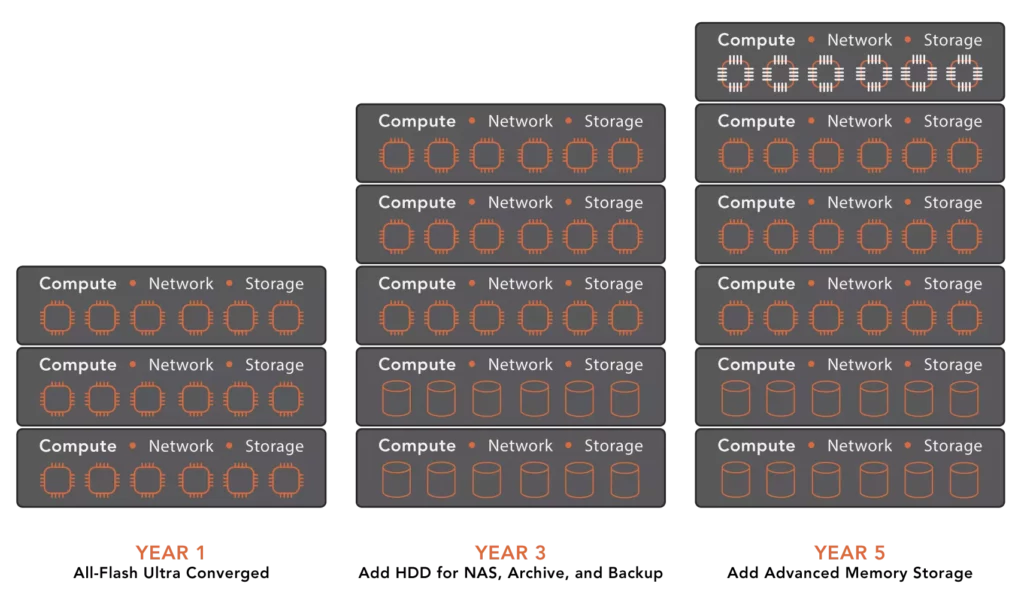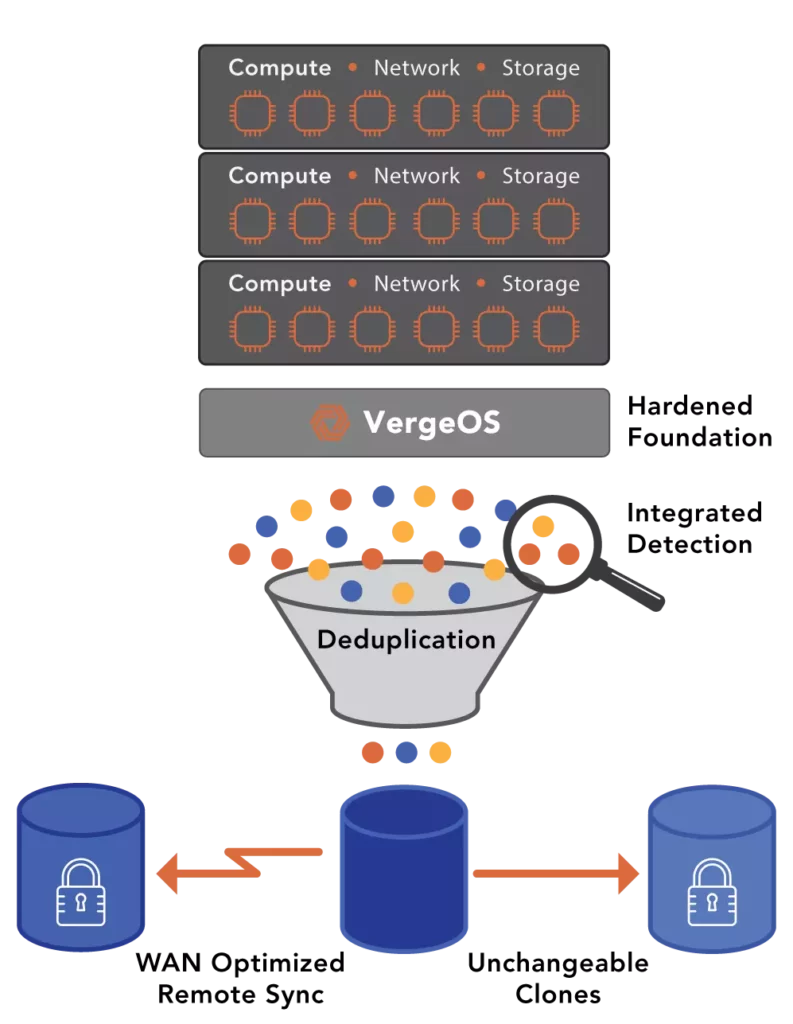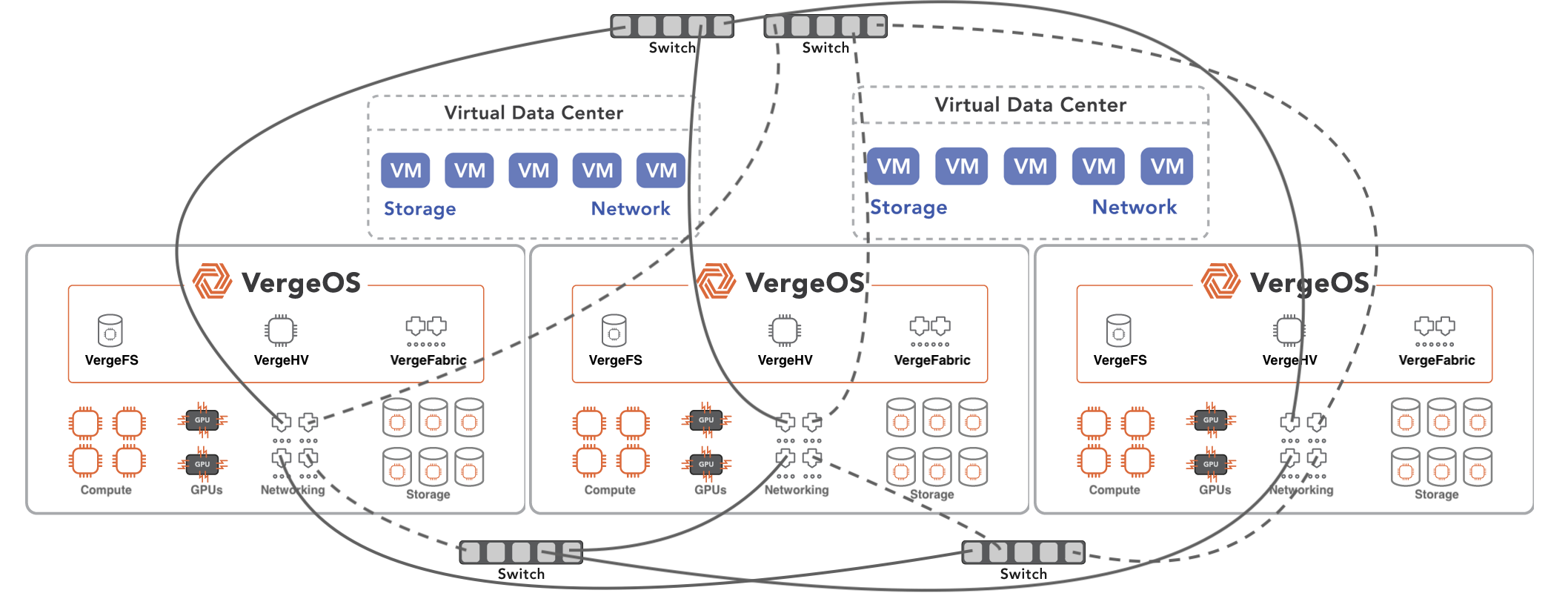Hyperconverged Infrastructures (HCI) were supposed to ease IT professionals’ management burdens, but flaws in their design explain why HCI doesn’t simplify IT. These flaws have led HCI, which should be the one infrastructure for the enterprise, to be a niche solution for corner use cases within the data center. Instead of simplifying through convergence, HCI solutions from companies like VMware and Nutanix exacerbate complexity.
The HCI Flaws
- HCI Isn’t Scalable
- HCI Isn’t Flexible
- HCI Isn’t Secure
Because of these three flaws, complex and expensive three-tier architectures with dedicated storage arrays, restrictive compute tiers, and proprietary network switches continue to flourish despite their own challenges. Can HCI be fixed so it can finally deliver its full promise?
HCI Isn’t Scalable
How can an architecture like HCI that is scale out by design, not scale? It’s true, though; HCI can’t scale large, and it can’t scale small. Most HCI vendors force you to start with three nodes, making HCI impractical for Edge and small offices. The inability to scale small and scale large is one reason why HCI doesn’t simplify IT.

At the same time, most HCI solutions can’t scale beyond eight or so nodes without serious performance concerns. These performance concerns stem from the fact that HCI solutions don’t actually converge the three data center tiers (networking, computing, and storage). They are three separate software packages, often from three separate vendors. HCI squeezes the three separate software-based tiers onto a single server. Each of these tiers has different lanes of communication between the servers. As a result, internode communication is exponentially increased by a factor of three.
UCI Solves the HCI Scale Issue
Ultraconverged Infrastructure (UCI) solutions, like VergeOS, solve both aspects of the scale issue. It can scale small, and it can scale large. Instead of using a separate application for networking, another for compute, and still another for storage, UCI is a single piece of very efficient code.

Thanks to UCI’s unification of the legacy IT stack into a single piece of software, there is only a need for a single lane of communication between nodes. The reduction in east-west traffic enables scaling beyond 200 nodes without significant network overhead. At the same time, the efficiency of the code base enables a two-node UCI environment to deliver the performance and cost-effectiveness that Edge and remote locations need. The common code base also means a unified GUI for simple administration and day-to-day operations. UCI simplifies IT by providing a single software package. It can support small offices and Edge locations while scaling to meet the needs of the primary data center.
HCI Isn’t Flexible
Another reason why HCI doesn’t simplify IT is that it restricts the type of nodes users can add to the cluster. The idea behind HCI is that as you add additional servers to the environment, you automatically scale each of the three data center tiers to support new applications or additional users. The reality is that most organizations don’t need or want to scale all three of these tiers simultaneously; sometimes, you only need additional computing power, and other times, you only need additional storage capacity.
While some HCI solutions can now add “storage-only” nodes, they compromise performance and place restrictions on data protection and efficiency. Practically speaking, most HCI solutions must use nearly identical nodes as they scale, or create an entirely separate instance with an entirely different node configuration. Each additional HCI instance further adds to data center fragmentation instead of converging it.
In some cases, vendors require customers to replace servers, even if they are only a few years old, to support the latest version of their software. This requirement is not optional with them; upgrading to the new hardware means replacing older hardware.
UCI Solves the Flexibility Issue
UCI simplifies IT by solving the flexibility issue. It allows a mixture of different nodes within the same instance. Within the instance, VergeOS can group like nodes together. Then IT can allocate some or all those resources to specific workloads. This flexible intelligence also means that customers don’t have to upgrade or replace hardware to run the latest version of the HCI software.
The efficiency of VergeOS enables customers to extract more serviceable life from aging servers while fully exploiting the capabilities of modern servers that are only a few months old. Servers within a single VergeOS instance can be from different decades, processor manufacturers, and storage types.

Nodes can also have different areas of focus. Some can be heavily weighted for computing power while using the storage from other nodes in the instance, and others can be heavily weighted for storage capacity or performance and provide that storage or performance to the rest of the instance.
HCI Isn’t Secure
The lack of a robust security strategy is another reason why HCI doesn’t simplify IT. Customers must fill data protection and ransomware resiliency gaps by using third-party applications and creating additional infrastructures. As a result, legacy HCI forces IT planners to look at threats like ransomware as a backup and recovery problem instead of as an infrastructure problem, which is what it really is.
After IT discovers a ransomware attack, the malware file must be found, stopped, and removed. Then, IT must methodically recover data. By only looking at ransomware as a data protection problem, the average downtime associated with a ransomware attack is typically measured in days and sometimes weeks.
UCI is Hardened and Secure
UCI simplifies IT by providing infrastructure-wide data protection and resiliency capabilities. First, VergeIO’s Virtual Data Centers (VDC), which encapsulate the entire data center, also shrink the attack surface available to ransomware. It is nearly impossible for a malware file infecting one VDC to cross over to another VDC.

Second, VergeOS’ snapshot capabilities are powered by IOclone, which provides independent, immutable copies. However, because VergeOS implements global inline deduplication at its core, clone/snapshot copies are also space efficient. Taking frequent immutable snapshots without impacting performance provides the second layer of defense against ransomware.
Third, VergeOS’ IOfortify provides early detection of a ransomware attack. With it, your notification comes minutes after an attack starts instead of coming from confused users hours later. This early detection, combined with frequent, immutable clones, means recovery occurs within minutes and with little to no data loss.
Finally, VergeOS operates as read-only firmware at its core and injects a copy of itself into each VDC. As a result, if a cyber-attack could ever get to the actual VergeOS operating environment, a known good copy at the core is available to replace it.
The Impact of HCI Complexity
The impact of HCI complexity and its limitations means that IT must use the legacy three-tier architecture. It is also why most IT professionals don’t think HCI can replace a SAN, even though it should be a better option for virtualized environments. While legacy three-tier architectures are more complicated and more expensive, they, through brute force, work through some of the issues mentioned above.
UCI fulfills and extends the potential of legacy HCI. Using a single code base allows IT to manage all aspects of infrastructure in a cohesive, straightforward manner. UCI has flexible scalability, extending to both large and small needs. UCI can mix nodes of different types, which enables true and long-lasting actual convergence. UCI’s integrated data protection capabilities eliminate the dependency on a separate data protection infrastructure. As a result, UCI delivers more widespread convergence than HCI, while delivering infrastructure-wide data resiliency.
To learn more about UCI and VergeIO, register to watch the VergeOS Architecture Deep Dive with our CTO and founder, Greg Campbell. You can also sign up for a virtual test drive and start running VergeOS in minutes.



